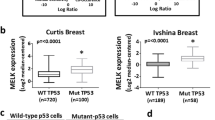Abstract
The human STYK1/NOK protein is approximately 30–35% similar to mouse fibroblast growth factor receptor 3 and a kinase homologue in D. melanogaster in the tyrosine protein kinase region. STYK1/NOK was identified as being up regulated in MDA-MB-231, an estrogen receptor-alpha negative breast cancer cell line, following 12 h of estrogen treatment at 1 × 10−9 M. On further investigation of STYK1/NOK in estrogen treated cell line MDA-MB-231, STYK1/NOK was up regulated at 6 h post treatment when compared to untreated cells. We also investigated the expression levels of STYK1/NOK in other breast cancer cell lines MCF-7, MDA-MB-231, BT-549, and MDA-MB-435S using QRT-PCR. In addition, the analysis of message accumulation was increased with other synthetic estrogen response modifiers. We propose that the regulation of STYK1/NOK is achieved independent of ERα and suggests further investigation to the relevance of this kinase in breast cancer progression.




Similar content being viewed by others
Abbreviations
- DES:
-
Diethylstilbestrol
- ERα:
-
Estrogen receptor alpha
- ERβ:
-
Estrogen receptor beta
- FGF:
-
Fibroblast growth factor
- PPT:
-
1,3,5-Tris94-hydroxyphenyl)-4-propyl-1H-pyrazole
- RAL:
-
Raloxifene hydrochloride
- STYK1/NOK:
-
Serine/Threonine/Tyrosine kinase 1
- TAM:
-
Tamoxifen citrate
References
Schiff R, Chamness GC, Brown PH (2003) Advances in breast cancer treatment and prevention: preclinical studies on aromatase inhibitors and new selective estrogen receptor modulators (SERMs). Breast Cancer Res 5:228–231
Shen Q, Brown PH (2003) Novel agents for the prevention of breast cancer: Targeting transcription factors and signal transduction pathways. J Mammary Gland Biol Neoplasia 8:45–73
Hajitou A, Baramova EN, Bajou K, Noe V, Bruyneel E, Mareel M, Collette J, Foidart JM, Calberg-Bacq CM (1998) FGF-3 and FGF-4 elicit distinct oncogenic properties in mouse mammary myoepithelial cells. Oncogene 17:2059–2071
Eswarakumar VP, Lax I, Schlessinger J (2005) Cellular signaling by fibroblast growth factor receptors. Cytokine Growth Factor Rev 16:139–149
Welm BE, Freeman KW, Chen M, Contreras A, Spencer DM, Rosen JM (2002) Inducible dimerization of FGFR1: development of a mouse model to analyze progressive transformation of the mammary gland. J Cell Biol 157:703–714
Cappellen D, De Oliveira C, Ricol D, de Medina S, Bourdin J, Sastre-Garau X, Chopin D, Thiery JP, Radvanyi F (1999) Frequent activating mutations of FGFR3 in human bladder and cervix carcinomas. Nat Genet 23:18–20
Ye X, Ji C, Huang Q, Cheng C, Tang R, Xu J, Zeng L, Dai J, Wu Q, Gu S, Xie Y, Mao Y (2003) Isolation and characterization of a human putative receptor protein kinase cDNA STYK1. Mol Biol Rep 30:91–96
Liu L, Yu XZ, Li TS, Song LX, Chen PL, Suo TL, Li YH, Wang SD, Chen Y, Ren YM, Zhang SP, Chang ZJ, Fu XY (2004) A novel protein tyrosine kinase nok that shares homology with platelet- derived growth factor/fibroblast growth factor receptors induces. Cancer Res 64:3491–3499
Chen Y, Li Y-H, Chen X-P, Gong L-M, Zhang S-P, Chang Z-J, Zhang X-F, Fu X-Y, Liu L (2005) Point mutation at single tyrosine residue of Novel Oncogene NOK abrogates tumorigenesis in nude mice. Cancer Res 65:10838–10846
Vladusic EA, Hornby AE, Guerra-Vladusic FK, Lakins J, Lupu R (2000) Signaling molecules implicated in heregulin induction of growth arrest and apoptosis. Oncol Rep 8(6):1203–1214
Jacob J, Sebastian KS, Devassy S, Priyadarsini L, Farook F, Shameem, Mathew D, Raghava S, Thampan RV (2006) Mole Cell Membrane estrogen receptors: Genomic actions and post transcriptional regulation. Endocrinol 246:34–41
Skliris GP, Lewis A, Emberley E, Peng B, Weebadda WK, Kemp A, Davie JR, Shiu RP, Watson PH, Murphy LC. Estrogen receptor-beta regulates psoriasin (S100A7) in human breast cancer. Breast Cancer Res Treat. 2006 Sep 29; [Epub ahead of print]
Thomas P, Pang Y, Filardo EJ, Dong J (2005) Identity of an estrogen membrane receptor coupled to a G protein in human breast cancer cells. Endocrinology 146(2):624–632
Acknowledgements
The authors would like to thank for support by grants from NCI P20CA091366, NIGMS S06GM008247, NIGMS R25GM060414 and NCRR G12RR003062 and the Avon Foundation. The authors are also grateful to Drs. J. Simons and Tameka Clemons for their editorial assistance.
Author information
Authors and Affiliations
Corresponding author
Rights and permissions
About this article
Cite this article
Kimbro, K.S., Duschene, K., Willard, M. et al. A novel gene STYK1/NOK is upregulated in estrogen receptor-alpha negative estrogen receptor-beta positive breast cancer cells following estrogen treatment. Mol Biol Rep 35, 23–27 (2008). https://doi.org/10.1007/s11033-006-9047-1
Received:
Accepted:
Published:
Issue Date:
DOI: https://doi.org/10.1007/s11033-006-9047-1




